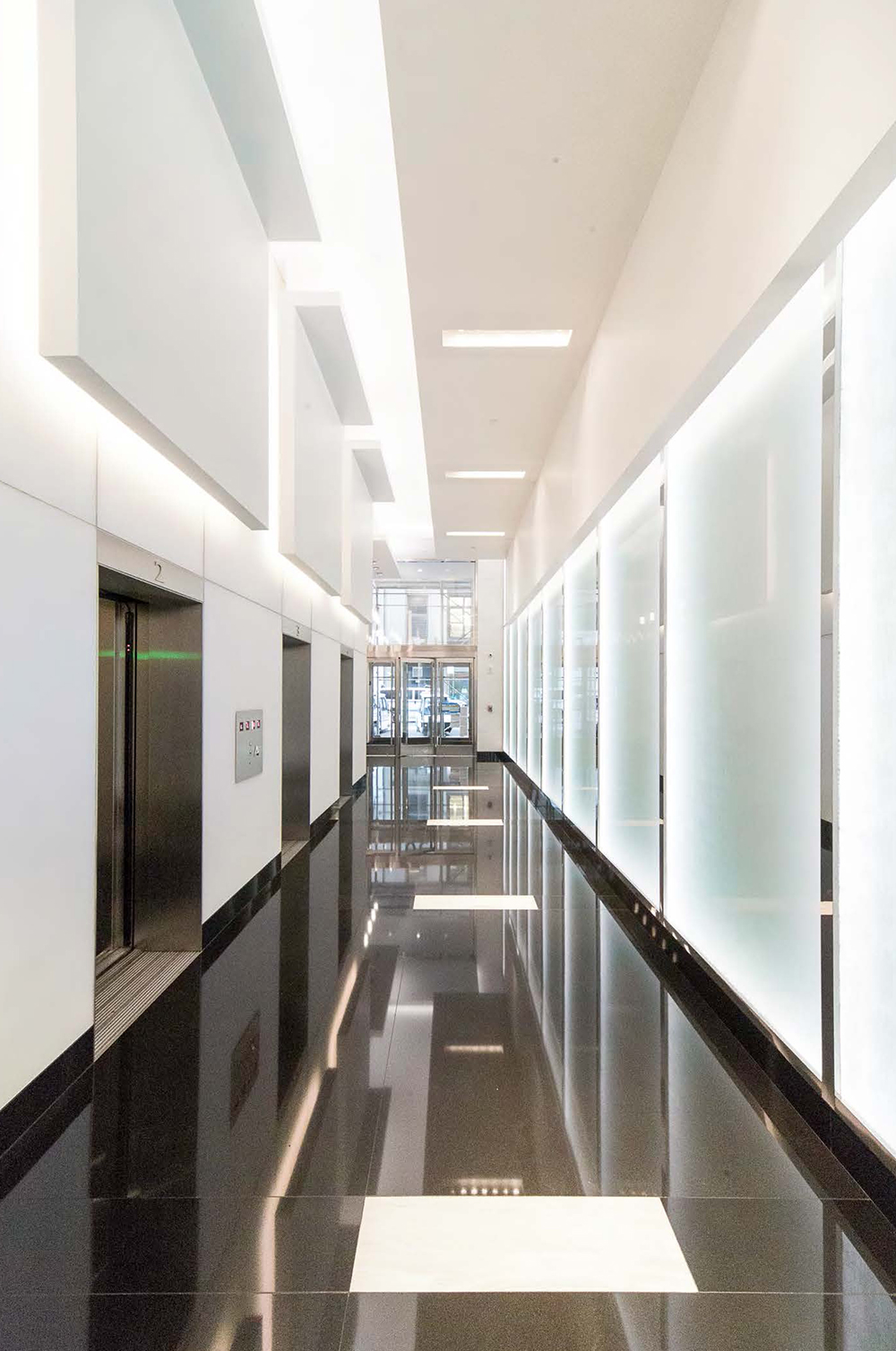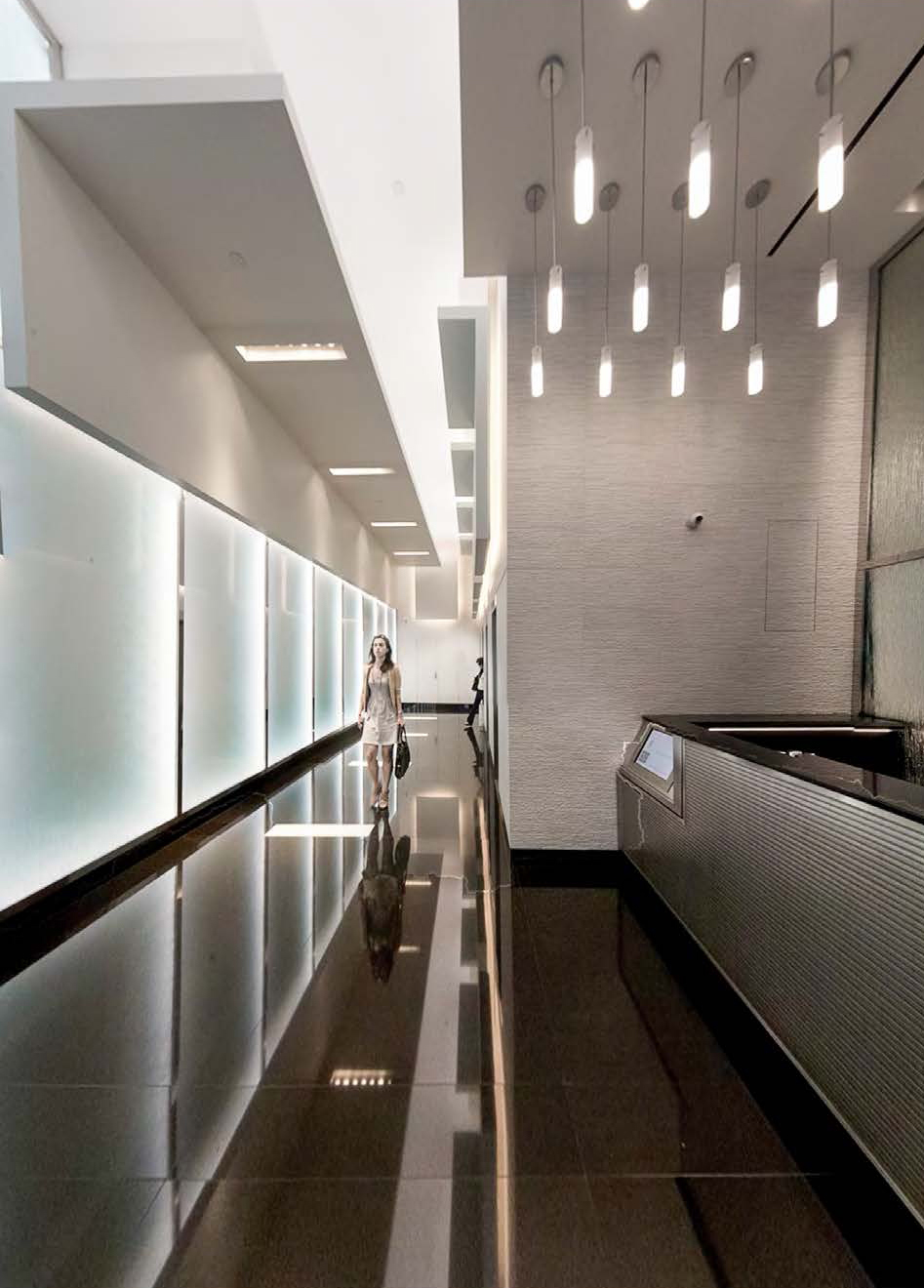
Bernstein Real Estates’ brilliant new lobby at 150 West 30th Street - by Enid Hamelin
Light is a force. An influence. Both in reality and fantasy. A tree grows to the light of the sun. Hope is the light at the end of the tunnel. We celebrate by lighting candles. People light up our lives with joy. A light bulb appears over head for a clever idea. Light lets us see. Affects our moods. Leads us out of the dark.
Why such an esoteric opening for an article about a new lobby? That’s because this lobby is all about light and how it makes you feel when you enter it. The transition that happens to you when you leave the congested New York City street with its smothering noise, hyper rush and grey concreteness. This lobby is designed to be not only boldly handsome but to also make you feel better. To help you face your work day with its brightness of possibility.
Some history
150 West 30th was built in 1925 by Alex Bernstein, considered the father of the fur community. A furrier who turned tradesman, he played a large part in the growth of the fur industry and fur district itself. Speaking seven languages he became a significant force amongst the growing number of furriers who depended on his business skills to get them started. First by providing financial support to new immigrants. Then by building buildings to sell their fashions. These weren’t just any buildings, they were designed to be temples to the fur business, filled with glamorous showrooms.
First impressions
When asked why he launched into this major and very costly renovation, owner Asher Bernstein, president of Bernstein Real Estate and Alex’s grandson, said, “I came into the lobby about a year and a half ago and I thought to myself, this doesn’t look inviting anymore. It just looks old. For the first time I paid attention to where I was. This space that I have taken for granted every day for years. Always rushing past it. That morning it just stopped working for me and I said to myself how will other people, new, younger tenants see it? It was at that moment that I understood that I had to rethink the space. I had forgotten what an impact an entry can make. The lobby that I was standing in, that had once been grand and spoke to a different audience and era, was not keeping up. The truth is, the demographics in this neighborhood, really the city, had changed. I realized it was necessary for us, the owners of the building, to do the same.”
Like all owners of historic properties in the city, the time had come to look to the future. This 90 year old icon was due for a makeover. Bernstein said, “We didn’t use words like high tech or modern. We weren’t looking to catch a trend. It wasn’t a style we were going for, it was a presence. We wanted to attract today’s emerging tenants. To be as current as they are.”
Bernstein had to admit that when he first started talking about the renovation he got a lot of disapproval. People were saying things like, “There is so much history here. The carved plaster ceiling and the marble walls and the bronze chandeliers mark an era of unreturnable grandeur.” The truth is that this was not same lobby that his grandfather created. In an effort to modernize the lobby in the mid-eighties, much of that original style was dismantled and replaced with front doors and a reception area that were out of place. It was no longer authentic. “What we were left with was a cultural hodge-podge. How could you be sentimental about that?” Bernstein said.
Mastering the project
When the decision was made to renovate, the goal was to find an architect that had some experience and sensitivity in a project like this. They chose Gavin Macrae-Gibson a New York-based architectural firm renowned for their ability to revise existing structures with taste and integrity. Gavin Macrae-Gibson, the force behind the company, has a master of arts degree from Cambridge University and a master of Architecture degree from Yale. His book, “The Secret Life of Buildings, an American Mythology for Modern Architecture,” reveals his philosophy for his signature style. It is the project, not the time nor the trend, that must define the work. This was evidenced in the rehabilitation of two important New York City libraries, the historic Ottendorfer Library and the Astor Hall entrance to the Main Library on Fifth Ave.
Gavin Macrae-Gibson calls himself a conceptualist. When asked he explains that it is important to think about a project from all sides. “The solution must make sense. It must do what it is supposed to do. Only after identifying purpose can we wrap that practical need in a creative idea.” He uses the word “transparency” in successfully achieving that goal. Adding, “Every project has its own truth.”
Making an entrance
What followed was a plan to make this lobby a proper and truthful gateway. For it to be a rite of passage from the outside world to the office where you spend the better part of your day. For that moment in time, as you walk through, you would be uplifted.
The result is an astonishing space. A victory in proportion and scale. This impact is achieved with materials that radiate and reflect. Four separate varieties of glass offer their illumination individually, but emerge in harmony. Conjoined to each other by pearlescent and articulating light. The effect is literally brilliant.
The lightness of being
As you enter through the full-height steel and glass doors, the lobby is designed to make you aware that you are leaving the drab, police car laden 30th Street and stepping into an exhilarating new world. A great wall of lights will illuminate your passage. What is not glass are bold surfaces of textured porcelain stone. The floor, a black reflecting granite is accented with white marble inlays. The information desk is modern and streamlined, with a digital directory. The ceiling hovers with massive cloud like blocks–floating panels of light. The elevators carry you to your destination in cabs of stainless and glass panels.
The new lobby image doesn’t stop there. They have introduced a modern look for their gate keeper as well. The predictable concierge stereo type has been rethought and replaced with a more timely appearance. Their gentleman at the door makes his first impression, very un-uniform, in a distinguished, navy blue Joseph Aboud suit.
A tenant, when asked, best describes it, “I don’t remember what the old lobby looked like, but this one is terrific.”
Enid Hamelin is a freelance writer, New York, N.Y.

